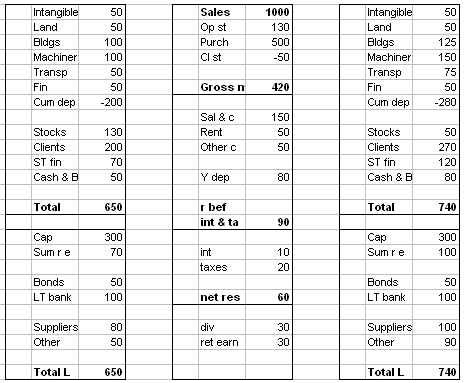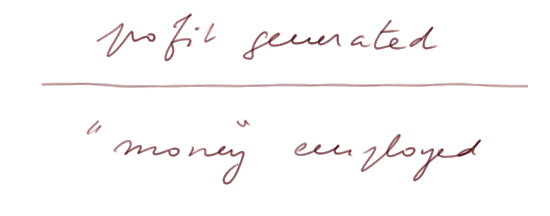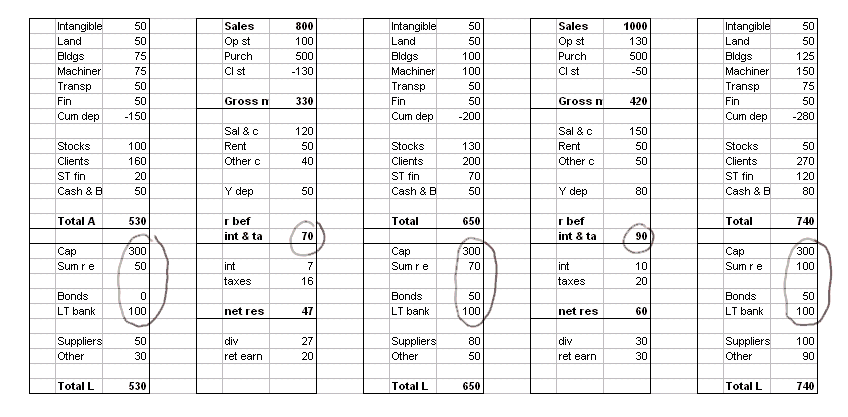General accounting
XII. 42. Ratios: the Return on Capital Employed (ROCE)
Video
General Accounting is one of the MIS (= management information systems) to manage the firm.
At the end of each accounting cycle, it produces 3 year-end documents
- the income statement
- the balance sheet
- the cash flow statement
We shall go one step further in the construction of synthetic figures, with ratios.
Ratios are used to assess the performance of the firm in three contexts:
- within one cycle
- over time (evolution of the ratios of the firm over several years)
- in comparison with competitors (that is somehow over "space")
There are four categories of ratios:
- Profitability ratios
- Liquidity ratios
- Efficiency ratios
- Financial ratios (also called "investments ratios")
In this lesson, we study the main profitability ratio: the ROCE (= Return on Capital Employed).
Other ratios will be studied in the next lesson.
The idea underlying profitability ratios is simple: if I tell you "last year firm F generated 60 million € of profit", is it a good performance or not?
We cannot answer without some yardstick to evaluate these 60 million €.
To assess the performance represented by this profit we need to know with what means:
- If it is with 1000 million € of "money employed", it is poor*.
- If it is with 100 million € of "money employed", it is brilliant.
(* well, it's not so bad!)
Here are the documents of one cycle (year n): beginning BS, IS of the year, and ending BS.

The "money employed" is represented by what we've called the Capital Employed (cf. lesson on "big measures in a BS") on the liability side of the BS.
You remember: the capital employed is the part of the liabilities which require an effort to get.
It is the sum of the Debt (= the "costly debts") which cost each year the interest charges, and the Equity (= "net worth" = capital + Σ retained earnings) which is remunerated with dividends.
CE = E + D
While the other liabilities (= suppliers and other creditors) represent free financing.
So we shall look at a ratio of the form

The Net Result (of 60 million €) depends on the structure of the CE.
- relatively more debts lead to less net result
- relatively less debts lead to more net result
Since we want to assess the profit generation capability of the CE disregarding their structure (that is, their origin, or nature), we shall not use on the numerator the Net Result, but rather the Operating Result (also called Result before Interest and Taxes).
And since the CE is a figure which changes during the accounting cycle, and we don't want to do mathematical calculus (using integration), we shall simply use the average value of the beginning CE and the ending CE.
So the ROCE of year n is

The general formula is

Let's compute the yearly ROCE over two years (year n-1 and year n)

For year n-1, we obtain

So the evolution of the ROCE is from 14,4% to 16,8%. This shows an improvement of the profitability of the firm from year n-1 to year n.
Finally, this ROCE is a measure that we shall compare to the cost of the funds (= the capital employed).
If the Equity and the Debt cost less than the ROCE (for instance if they costs 10% per year and the ROCE is 15%), then investing money into the firm is profitable since it will generate more than its cost.
This is a crude first financial reasoning. There is a lot more to say about investing financially into a firm.
For example, some firms may pay no dividends and yet be quite good investment opportunities. Remember, however, that what we want in the end is these very elusive signs called cash (cf. lesson on "what is cash").
We shall see more refined analyses, for bondholders as well as for shareholders, in a course in Finance.



